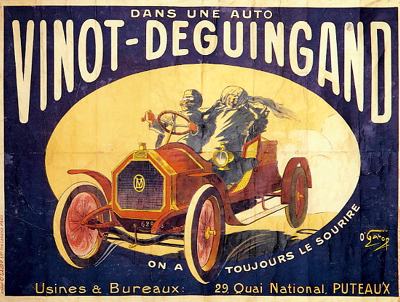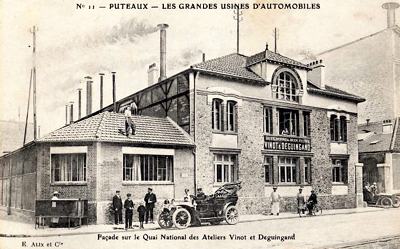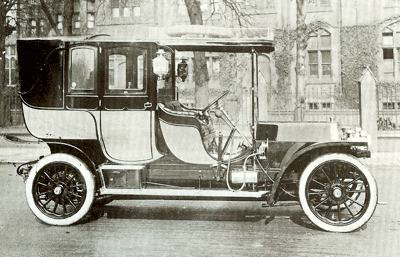Vinot-Deguingand
|
1901 - 1932 |
Country: |
 |
|
La Silencieuse
First announced in 1901, Vinot-Deguingand was originally built in Puteaux, near Paris, but relocated to Nanterre some time after production began. The early models were marketed in English speaking countries (of which we can only find evidence that this meant England) under the name 'La Silencieuse', and were fairly advanced machines for the day, with vertical twin 5
½ hp engines mounted in a pressed steel chassis with belt and chain final drive.
As the cars got bigger (in 1903 there was a 10hp twin, and 14hp and 18hp fours) they took the retro-grade step of adopting armoured wood chassis. However in 1905 the larger cars in the range were back with pressed steel chassis, and a comprehensive line-up of models was offered.
The 1906 Crystal Palace Automobile Show
At the 1906 Crystal Palace Automobile Show, the English agents, T. J. Harman & Company of Regent Street, offered a 12/16 hp 2212cc, a 14/20hp of 2799 cc, a 20/30 hp of 3666 cc, a 30/45hp of 5817cc and a 35/50hp 6-cylinder of 6999 cc. Prices in the UK ranged from £320 to £930. These cars were presented at Olympia at the end of that year, but by the end of the following season the English agency had changed hands and was now operated by the coachbuilders William Cole & Sons of Kensington.
Their 1907 Olympia stand featured the new 16/24hp model with shaft-drive and four-speed gearbox, which was priced at £440 in chassis form. They also exhibited a landaulette limousine on this chassis, costing £700 complete and seating seven. An electric light was fitted to the interior of the body. On the 24/32 hp chassis, which was new that year, they exhibited a full limousine, again with seven seats and 'fitted with two chairs, three electric lights, canteen, cigar lighter, silk velvet curtains etc.' This model cost £860 complete.
A year later, the agency had reverted to Harmans, and all models shown at Olympia now had shaft drive. Vinot acquired Gladiator in 1909, and the two marques differed only in the design of their radiators for the next decade; with the initial difference that the 24 hp model was only available as a Vinot. By 1910, Vinot were controlling their own destinies in England, with an office in Great Portland Street, London. A new 12/16 hp model appeared with a monobloc engine and pressure lubricated crankshaft, while the 25/30 hp was demonstrated and had an L-head and improved lubrication.

 The Vinot-Deguingand factory, Nanterre, France.
The Vinot-Deguingand factory, Nanterre, France.
 1910 Vinot.
1910 Vinot. |
Leon and Lucien Molon
There was a total revision of the range in 1911, which saw a new 10/ I2 hp of 1693 cc with a monobloc engine, which cost £280 with two-seated torpedo bodywork, a 15.9 hp of 2212 cc, priced at £425 with four-seated touring
bodywork and a 25130 hp of 4166 cc which, fitted with all-weather four-seated coachwork, cost £650. The year 1912 saw the marque's first serious entry into competition, with a team of three specially-built cars competing in the Coupe de l' Auto. These had F-head ioe engines and streamlined
bodywork with long tails. Drivers were the brothers Leon and Lucien Molon and Vonatum; the latter achieved the marque's best placing in this event by coming in seventh.
The Molons also took part with these cars in the
Grand Prix de' France and finished third and fifth. There was little change in the touring models of Vinot before the Great War, apart from the introduction of a new 15/20hp model of 2614cc in 1913, the same year that an increase in stroke brought the swept volume of the 25/30 hp up to 4807 cc. The Vinot stand at the 1919 Olympia Motor Show was entirely occupied by 15/20s little changed from their pre-war counterparts except for an inflated price and the adoption of electric lighting and starting. Most British Vinot models at that time seemed to be fitted with Park Ward coachwork.
Vinot's alter ego, Gladiator, went out of business in 1920, and the following year came the first new post-war model, the 1795 cc 11/25 hp, of conventional design save for the adoption of alloy pistons and overhead valves; the use of pump and splash lubrication was a definite step back compared with pre-war models. The 15/20 also acquired overhead valves in 1922, when it was designated Type BO. Vinot sales were apparently falling off by this time as the company was trying to drum up orders with a guarantee that should chassis prices be reduced before 30 June 1921, the difference in purchase price would be refunded to the customer.
The Joy of Living, Thanks To The 11/25 hp Vinot BP Model
The 11/25 was a typical French light car, with a vee
radiator similar in appearance to that of the DFP; the British Vinot company obviously wished to upgrade the car's social standing with advertising that waxed lyrical; 'Now that the better weather is with us once again, your thoughts undoubtedly have turned to the beauties and health-giving properties of the countryside, in short, where you feel the 'joy of living.' Nothing will help you more to realise these pleasures than the 11/25 hp Vinot BP Model. It is built for that purpose.'
At the 1923 Olympia Show a new 12/25 hp Vinot appeared; this was the 11/25 bored out to give a capacity of 1847 cc and now available with the option of front wheel
brakes at an extra cost of £25 on the chassis price of £425. Front wheel
brakes were standard the following year, but there was a warning of impending disaster at Olympia, where the Vinot stand was shared by Donnet-Zedel. In fact, Donnet-Zedel had just acquired the Vinot factory at Nanterre, and no more Vinots were seen at Olympia, though the marque continued a shadowy existence for another couple of years.
However, there was a new Deguingand light car with a 735 cc Duplex engine and sub-basic engineering in 1928, designed by Marcel Violet, who had previously conceived the Violet-Bogey cyclecar. But this last vestige of the old Vinot-Deguingand concern lost its identity in 1932 and was rechristened as a Donnet. It lasted only a year before Donnet itself was extinct and its factory acquired by Simca.



